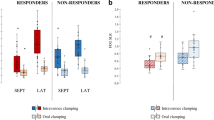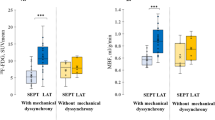Abstract
Background
Up to 50% of patients do not respond to Cardiac Resynchronization Therapy (CRT). Recent work has focused on quantifying mechanical dyssynchrony and left ventricular scar. Septal reverse-mismatch (R-MM) (reduced FDG uptake vs perfusion) has been observed in patients with cardiomyopathy and prolonged QRS duration. We hypothesized that a greater quantity of septal R-MM would indicate a greater potential for reversibility of the cardiomyopathy, when the dyssynchrony is improved with CRT. Therefore, this study’s objective was to assess whether greater septal R-MM pattern predicts response to CRT.
Methods and Results
Forty-nine patients had pre-implant Rubidium-82 and Fluorine-18-fluorodeoxyglucose PET scanning. Total and regional left ventricular scar size and extent of R-MM were calculated. Response to CRT was defined as ≥10% improvement in left ventricular end-systolic volume or ≥5% absolute ejection fraction improvement. In the non-ischemic cardiomyopathy subset non-responders had significantly less septal R-MM than responders (13.1% compared to 27.1%, P = .012). There were correlations between the extent of septal R-MM and the increase in ejection fraction (r = 0.692, P = .0004) and reduction in left ventricular end-systolic volume (r = −0.579, P = .004). For each 5% absolute increase in extent of septal R-MM the odds ratio of being a responder was 2.17 (95% CI 1.15, 4.11, P = .017). Extent of septal R-MM displayed high sensitivity and specificity (area under curve = 0.855, P = .017) to predict response.
Conclusions
In patients with non-ischemic cardiomyopathy, greater extent of septal glucose metabolic R-MM pattern, predicted response to CRT. This parameter may be useful for identifying patients who benefit from CRT.





Similar content being viewed by others
References
Bristow MR, Saxon LA, Boehmer J, Krueger S, Kass DA, De Marco T, et al. Cardiac-resynchronization therapy with or without an implantable defibrillator in advanced chronic heart failure. N Engl J Med 2004;350:2140-50.
Cleland JG, Daubert JC, Erdmann E, Freemantle N, Gras D, Kappenberger L, et al. The effect of cardiac resynchronization on morbidity and mortality in heart failure. N Engl J Med 2005;352:1539-49.
McAlister FA, Ezekowitz J, Dryden DM, Hooton N, Vandermeer B, Friesen C, et al. Cardiac resynchronization therapy and implantable cardiac defibrillators in left ventricular systolic dysfunction. Evid Rep Technol Assess (Full Rep) 2007;152:1-199.
Birnie DH, Tang AS. The problem of non-response to cardiac resynchronization therapy. Curr Opin Cardiol 2006;21:20-6.
Chung ES, Leon AR, Tavazzi L, Sun JP, Nihoyannopoulos P, Merlino J, et al. Results of the Predictors of Response to CRT (PROSPECT) trial. Circulation 2008;117:2608-16.
Diaz-Infante E, Mont L, Leal J, Garcia-Bolao I, Fernandez-Lozano I, Hernandez-Madrid A, et al. Predictors of lack of response to resynchronization therapy. Am J Cardiol 2005;95:1436-40.
Pitzalis MV, Iacoviello M, Romito R, Massari F, Rizzon B, Luzzi G, et al. Cardiac resynchronization therapy tailored by echocardiographic evaluation of ventricular asynchrony. J Am Coll Cardiol 2002;40:1615-22.
Yu CM, Fung JW, Zhang Q, Chan CK, Chan YS, Lin H, et al. Tissue Doppler imaging is superior to strain rate imaging and postsystolic shortening on the prediction of reverse remodeling in both ischemic and nonischemic heart failure after cardiac resynchronization therapy. Circulation 2004;110:66-73.
Yu CM, Zhang Q, Chan YS, Chan CK, Yip GW, Kum LC, et al. Tissue doppler velocity is superior to displacement and strain mapping in predicting left ventricular reverse remodeling response after cardiac resynchronization therapy. Heart 2006;92:1452-6.
Penicka M, Bartunek J, De Bruyne B, Vanderheyden M, Goethals M, De Zutter M, et al. Improvement of left ventricular function after cardiac resynchronization therapy is predicted by tissue doppler imaging echocardiography. Circulation 2004;109:978-83.
Tatsumi K, Tanaka H, Yamawaki K, Ryo K, Omar AM, Fukuda Y, et al. Utility of comprehensive assessment of strain dyssynchrony index by speckle tracking imaging for predicting response to cardiac resynchronization therapy. Am J Cardiol 2011;107:439-46.
Auger D, Bertini M, Marsan NA, Hoke U, Ewe SH, Thijssen J, et al. Prediction of response to cardiac resynchronization therapy combining two different three-dimensional analyses of left ventricular dyssynchrony. Am J Cardiol 2011;108:711-7.
Bleeker GB, Kaandorp TA, Lamb HJ, Boersma E, Steendijk P, de Roos A, et al. Effect of posterolateral scar tissue on clinical and echocardiographic improvement after cardiac resynchronization therapy. Circulation 2006;113:969-76.
White JA, Yee R, Yuan X, Krahn A, Skanes A, Parker M, et al. Delayed enhancement magnetic resonance imaging predicts response to cardiac resynchronization therapy in patients with intraventricular dyssynchrony. J Am Coll Cardiol 2006;48:1953-60.
Ypenburg C, Roes SD, Bleeker GB, Kaandorp TA, de Roos A, Schalij MJ, et al. Effect of total scar burden on contrast-enhanced magnetic resonance imaging on response to cardiac resynchronization therapy. Am J Cardiol 2007;99:657-60.
Birnie DH, de Kemp R, Ruddy TD, Tang AS, Williams K, Guo A, et al. Effect of lateral wall scar on reverse remodeling with cardiac resynchronization therapy. Heart Rhythm 2009;6:1721-6.
Prinzen FW, Augustijn CH, Arts T, Allessie MA, Reneman RS. Redistribution of myocardial fiber strain and blood flow by asynchronous activation. Am J Physiol 1990;259:H300-8.
Prinzen FW, Hunter WC, Wyman BT, McVeigh ER. Mapping of regional myocardial strain and work during ventricular pacing: Experimental study using magnetic resonance imaging tagging. J Am Coll Cardiol 1999;33:1735-42.
Wyman BT, Hunter WC, Prinzen FW, McVeigh ER. Mapping propagation of mechanical activation in the paced heart with MRI tagging. Am J Physiol 1999;276:H881-91.
Inoue N, Takahashi N, Ishikawa T, Sumita S, Kobayashi T, Matsushita K, et al. Reverse perfusion-metabolism mismatch predicts good prognosis in patients undergoing cardiac resynchronization therapy: A pilot study. Circ J 2007;71:126-31.
Thompson K, Saab G, Birnie D, Chow BJ, Ukkonen H, Ananthasubramaniam K, et al. Is septal glucose metabolism altered in patients with left bundle branch block and ischemic cardiomyopathy? J Nucl Med 2006;47:1763-8.
Neri G, Zanco P, Bertaglia E, Zerbo F, Zanon F, Buchberger R. Myocardial perfusion and metabolic changes induced by conventional right and biventricular pacing in dilated cardiomyopathy evaluated by positron emission tomography. Ital Heart J 2002;3:637-42.
Nowak B, Sinha AM, Schaefer WM, Koch KC, Kaiser HJ, Hanrath P, et al. Cardiac resynchronization therapy homogenizes myocardial glucose metabolism and perfusion in dilated cardiomyopathy and left bundle branch block. J Am Coll Cardiol 2003;41:1523-8.
Neri G, Zanco P, Zanon F, Buchberger R. Effect of biventricular pacing on metabolism and perfusion in patients affected by dilated cardiomyopathy and left bundle branch block: Evaluation by positron emission tomography. Europace 2003;5:111-5.
Beanlands RS, Ruddy TD, de Kemp RA, Iwanochko RM, Coates G, Freeman M, et al. Positron emission tomography and recovery following revascularization (PARR-1): The importance of scar and the development of a prediction rule for the degree of recovery of left ventricular function. J Am Coll Cardiol 2002;40:1735-43.
Beanlands RS, Nichol G, Huszti E, Humen D, Racine N, Freeman M, et al. F-18-fluorodeoxyglucose positron emission tomography imaging-assisted management of patients with severe left ventricular dysfunction and suspected coronary disease: A randomized, controlled trial (PARR-2). J Am Coll Cardiol 2007;50:2002-12.
Massardo T, Gal RA, Grenier RP, Schmidt DH, Port SC. Left ventricular volume calculation using a count-based ratio method applied to multigated radionuclide angiography. J Nucl Med 1990;31:450-6.
Lalonde M, Birnie D, Ruddy TD, de Kemp RA, Wassenaar RW. SPECT blood pool phase analysis can accurately and reproducibly quantify mechanical dyssynchrony. J Nucl Cardiol 2010;17:803-10.
Bashore TM, Stine RA, Shaffer PB, Bush CA, Leier CV, Schaal SF. The noninvasive localization of ventricular pacing sites by radionuclide phase imaging. Circulation 1984;70:681-94.
Botvinick EH, Frais MA, Shosa DW, O’Connell JW, Pacheco-Alvarez JA, Scheinman M, et al. An accurate means of detecting and characterizing abnormal patterns of ventricular activation by phase image analysis. Am J Cardiol 1982;50:289-98.
Machac J, Bacharach SL, Bateman TM, Bax JJ, Beanlands R, Bengel F, et al. Positron emission tomography myocardial perfusion and glucose metabolism imaging. J Nucl Cardiol 2006;13:e121-51.
Klein R, Lortie M, Adler A, Beanlands R, deKemp R. Fully automated software for polar-map registration and sampling from PET images. IEEE Nucl Sci Symp Conf Rec 2006;6:3185-8.
Dilsizian V, Bacharach SL, Beanlands RS, Bergmann SR, Delbeke D, Gropler RJ, et al. PET myocardial perfusion and metabolism clinical imaging. J Nucl Cardiol 2009;16:651.
Vitale GD, de Kemp RA, Ruddy TD, Williams K, Beanlands RS. Myocardial glucose utilization and optimization of (18)F-FDG PET imaging in patients with non-insulin-dependent diabetes mellitus, coronary artery disease, and left ventricular dysfunction. J Nucl Med 2001;42:1730-6.
Kerlan JE, Sawhney NS, Waggoner AD, Chawla MK, Garhwal S, Osborn JL, et al. Prospective comparison of echocardiographic atrioventricular delay optimization methods for cardiac resynchronization therapy. Heart Rhythm 2006;3:148-54.
Cerqueira MD, Weissman NJ, Dilsizian V, Jacobs AK, Kaul S, Laskey WK, et al. Standardized myocardial segmentation and nomenclature for tomographic imaging of the heart: A statement for healthcare professionals from the Cardiac Imaging Committee of the Council on Clinical Cardiology of the American Heart Association. Circulation 2002;105:539-42.
Altehoefer C, vom DJ, Buell U. Septal glucose metabolism in patients with coronary artery disease and left bundle-branch block. Coron Artery Dis 1993;4:569-72.
Zanco P, Desideri A, Mobilia G, Cargnel S, Milan E, Celegon L, et al. Effects of left bundle branch block on myocardial FDG PET in patients without significant coronary artery stenoses. J Nucl Med 2000;41:973-7.
Depre C, Shipley GL, Chen W, Han Q, Doenst T, Moore ML, et al. Unloaded heart in vivo replicates fetal gene expression of cardiac hypertrophy. Nat Med 1998;4:1269-75.
Bleeker GB, Mollema SA, Holman ER, Van d Veire N, Ypenburg C, Boersma E, et al. Left ventricular resynchronization is mandatory for response to cardiac resynchronization therapy: Analysis in patients with echocardiographic evidence of left ventricular dyssynchrony at baseline. Circulation 2007;116:1440-8.
Chen J, Bax JJ, Henneman MM, Boogers MJ, Garcia EV. Is nuclear imaging a viable alternative technique to assess dyssynchrony? Europace 2008;10:iii101-5.
Henneman MM, Chen J, Ypenburg C, Dibbets P, Bleeker GB, Boersma E, et al. Phase analysis of gated myocardial perfusion single-photon emission computed tomography compared with tissue Doppler imaging for the assessment of left ventricular dyssynchrony. J Am Coll Cardiol 2007;49:1708-14.
Sutton MG, Plappert T, Hilpisch KE, Abraham WT, Hayes DL, Chinchoy E. Sustained reverse left ventricular structural remodeling with cardiac resynchronization at one year is a function of etiology: Quantitative Doppler echocardiographic evidence from the Multicenter InSync Randomized Clinical Evaluation (MIRACLE). Circulation 2006;113:266-72.
Acknowledgments
We thank Leslie Carlin for co-ordination of the study; Linda Garrard and May Aung for help with the PET scans and Keri O’Reilly for secretarial assistance.
Conflict of interest
The authors have indicated that they have no financial conflicts of interest.
Author information
Authors and Affiliations
Corresponding author
Additional information
Funding Sources
This study was funded by project Grant from the JP Bickell Foundation and supported in part by a program grant from the Heart and Stroke Foundation of Ontario (HSFO) (#PRG6242). Rob Beanlands is a Career Investigator supported by the HSFO. Dr Tang is a Canadian Institute of Health Research (CIHR) chair.
Rights and permissions
About this article
Cite this article
Birnie, D., de Kemp, R.A., Tang, A.S. et al. Reduced septal glucose metabolism predicts response to cardiac resynchronization therapy. J. Nucl. Cardiol. 19, 73–83 (2012). https://doi.org/10.1007/s12350-011-9483-8
Received:
Accepted:
Published:
Issue Date:
DOI: https://doi.org/10.1007/s12350-011-9483-8




